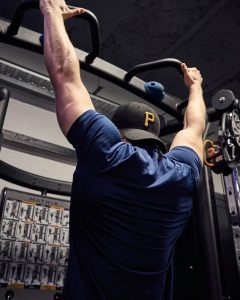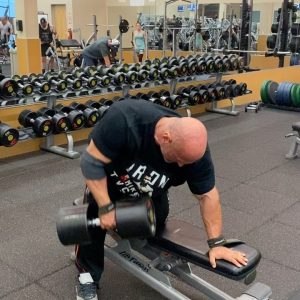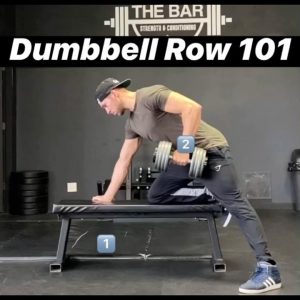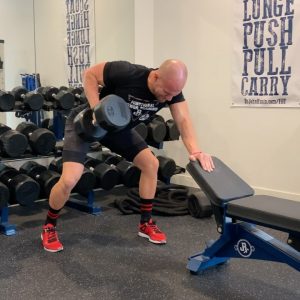dumbbell set
How to Do a Dumbbell Row : Detailed Guide
The dumbbell row is an exercise that is popular all the time. As a unilateral exercise, it trains one side of your body at a time. It’s so easy to do – you row your arm to your side while kneeling on a bench – and you just need to prepare one dumbbell to do the exercise One-arm activities help balance muscle and lose calories with the development of your workout.
In this article, we’ll cover everything you need to know about dumbbell row.
1. How to Do a Dumbbell Row
2. Benefits of a Dumbbell Row
3. Muscles Worked by the Dumbbell Row
4. Who Should use Dumbbell Row To Their Workouts?
5. Dumbbell Row Sets, Reps, and Programming Recommendations
6. Variations of the Dumbbell Row
7. Dumbbell Row Alternatives
8. Dumbbell Row – Mistakes to Avoid
9. Exercises using Dumbbell Rows
How to Do a Dumbbell Row

1. Stand vertically next to the training bench, on the side you intend to row on, and place a dumbbell next to it. Place your non-rowing hand and your knee on the same side as you on the bench, with your other foot firmly on the floor. Tense your back so that it is completely flat. Now, reach down with your free hand and grab a dumbbell. Reset yourself so that your back is straight again.
Form tip : Reach your non-throwing hand into the bench to create more full body tension.
2. Do not row the weight with your shoulders. Your shoulders should remain relaxed. Squeeze your shoulder blades together and use your elbows to lead the row. Pretend you are starting a lawn mower. Your elbows should be pulled over your torso and the dumbbell should almost touch your hips.
Form tip : If you do this correctly, you should feel a lot of tension in your lats, on the side of your back.
3. Once you have reached the top position, contract the back muscles maximally to increase muscle engagement. This should happen in each repetition. Once you feel your back actively contracting, lower the load with the same slightly arched movement and repeat.
Form Tip : When lowering the weight, do not lose tension in the back muscles.
Benefits of a Dumbbell Row

Consider the benefits of frequently practising dumbbell rows:
· Dumbbell rows can enhance your posture – By constructing your top-frame strength, the dumbbell row is one of the best exercises for improving your posture.
· Dumbbell rows contain a vast variety of movements – The dumbbell row permits a different type of movement than the conventional barbell row, improving your shoulder and elbow mobility.
· Dumbbell rows can boom grip strength – A dumbbell row is a superb choice for constructing your grip strength, mainly if you’re a beginner lifter. Practice dumbbell rows as a warm-as
· Dumbbell rows assist you to construct a more full lower back – Dumbbell rows placed unique emphasis on your lower back muscular tissues, including the posterior deltoids, latissimus dorsi, trapezius, teres major, and rhomboids.
· Dumbbell rows function muscles to your top body – Although the dumbbell row prioritizes your lower back muscular tissues, it additionally offers a complete top-frame exercise via way of means of activating numerous different muscle agencies, which include your chest muscular tissues, centre muscular tissues, glutes, decrease lower back muscular tissues, and triceps.
Muscles Worked by the Dumbbell Row
The dumbbell row usually hits muscular tissues for your return; however additionally improves middle stability, even as attractive muscular tissues for your shoulder, biceps, and triceps. The muscular tissues laboured are as follow:
· Trapezius – placed throughout your shoulder blades withinside the higher returned
· Posterior deltoids in the back of the shoulders
· Erector spinae that lie alongside the backbone and the rotator cuff
· Latissiumus dorsi – the large muscle alongside the produced of the ribs
· Rhomboids – the more minor, higher returned muscle
· Biceps muscular tissues of the higher arm will assist with joint stabilization
· Triceps
· Upper-Back-Muscles
Who Should use Dumbbell Row To Their Workouts?
The competitor bunches who advantage from adding dumbbell rows to their exercise schedules are powerlifters, Olympic lifters, and CrossFitters.
· Powerlifters – The dumbbell row fortifies the back muscles, your hold, and your arms intensely. Powerlifting competitors depend vigorously on their back and grasp capacities to perform deadlifts and whatever other development that requires the individual to hunch down.
· Crossfitters – CrossFitters can utilize the dumbbell row to fix any lopsidedness strength on the back. It further develops the competitor’s exhibition when doing pull-ups and deadlifts, for instance.
· Olympic lifters – Olympic weightlifters need back muscles to maintain strength and stance over the long run with weighty burdens.
Dumbbell Row Sets, Reps, and Programming Recommendations
Underneath, we list three different ways to program dumbbell rows into your routine, relying upon your objective.

To Gain Strength
When you feel happy performing dumbbell rows, you can up the weight and gradually decrease the reps to zero in on strength gains. Start by performing four to six arrangements of four to eight reiterations with extremely testing loads. Likewise, this is an incredible set and rep plan to do with the chest-upheld row variations beneath.
To Improve Muscle Endurance
If you’re hoping to condition your back and arm muscles, you can perform a few arrangements of 20 to 30 reps with a moderate burden. The grasp will be a restricting variable here, so wear lifting ties if you’re hoping to focus on the back.
To Gain Muscle
Acquiring muscle is about moderate volume with moderate weight. Take a stab at performing three to five arrangements of eight to 12 or 15-20 reiterations with a medium to weighty burden. You ought to likewise consider messing with your lifting beat to control your time under pressure.
Variations of the Dumbbell Row

The following are two dumbbell row variations to develop grit, hypertrophy and further develop pulling execution.
Dumbbell Renegade Row
The renegade dumbbell row is a one-sided row done in a board position building up centre dependability, scapular strength, and absolute body coordination. This activity requests the centre muscles (obliques) and can increment both back and centre strength.
Incline Bench Dumbbell Row
The incline seat dumbbell row should be possible by lying inclined on an inclined seat, so the chest is confronting downwards at a 30-45 degree point. By putting the body on the chair, you limit pressure or potentially solid requests to balance out and support the body and burden in the twisted around the position.
This can be advantageous to limit extra strain on the back and hips. This position can likewise assist with expanding back strength and advancement by defining any limits one might have because of weakness when supporting themselves in the twisted around the place.
Symmetrical position one-arm dumbbell row
You can advance the activity when you’re alright with the standard one-arm dumbbell row by standing square onto the seat. Rather than supporting yourself with your leg and hand on the chair, you’ll have one hand on it while you row with the other. This expands the test to your centre since you’ll need to work more earnestly against the load to hold your middle set-up while you row it here and there.
Remain with your feet shoulder-width separated and pivot at the hips to hang over the seat, on the one hand, pushing your bum back and keeping your back straight. Row the load up, ensuring that your arm – not your middle – moves during the activity.
Gym ball one-arm dumbbell row
Changing out the seat for a temperamental inflatable ball is a surefire approach to expand the work your centre needs to do to keep you still while you play out your rows. This makes the activity a superior all-around exercise regardless of whether you will not have the option to lift as much weight as when inclining toward a steady surface.
Dumbbell Row Alternatives

Three dumbbell row options can work on back strength, muscle hypertrophy, and stance.
Knolls Row
Named after professional jock and mentor John Meadows, the Meadows row uses a unique point and hand arrangement to develop massive back grit and size. The expanded scope of movement permits lifters to crush and stretch the lats more readily to advance substantial harm and growth.
Twisted around Barbell Row
The Bent-Over free weight row is a standard row development that creates back strength and size and further develops pulling execution. This row variety is finished with a free weight, which considers a heavier burden to be lifted. In case you’re hoping to work on your solidarity, this is an incredible variety.
Trap-Bar Seal Row
The seal row is a chest-upheld row variety that objectives the back muscles while limiting the hamstring, glutes, and lower back contribution. This is as near a back disconnection development as you can get, and utilizing the snare bar guarantees a more agreeable, wrist-accommodating hold (which likewise takes into consideration more weight lifted).
Dumbbell Row – Mistakes to Avoid
· Try not to over-burden when starting the activity. This will fortify your lats and disregard the more modest stabilizer muscles from your back and particularly your centre. Start with more modest loads, more reps (15-20), and crush the shoulder bones during the development. Increment the heap after several sets with a fairer measure of weight.
· Move the shoulder bones, not the arm. Your shoulder bones should start the row development, not your arms. Likewise, abstain from pivoting your body when rowing, as this forestalls your scapular muscles to be utilized. Play out the row development in a controlled manner. Try not to make forces with the whole body by bumping and jolting.
· Keep your grounded foot jumped back. The foot that is contacting the ground should not be near the hand that will play out the row, limiting the space to develop the activity. By putting the foot further back, it opens up the lat muscle to work it better.
· Consistently, you should keep your back straight and not bent. Your head should follow a similar bearing as your middle, so stay away from forward or throwing back the lead.
· Much as different compound exercises that use heavier weights like deadlifts and bench presses
Exercises using Dumbbell Rows
Cross Body Hammer Curl Exercise
Muscles worked
Brachialis
Lower arms
Biceps
How to do it: One all at once, twist such that each weight-up towards your contradicting shoulder. The return has taken care of to the beginning position and rehash on the opposite side.
Why: To dominate the weapons contest, isolate and prevail. Zeroing in on each arm, in turn, makes a vast neural drive, which draws in the sensory system to select more muscle filaments.
Step-ups Exercise
Muscles worked
Hamstrings
Glutes
Quads
How to do it: Move your right foot onto the raised stage and push up through your impact point to lift yourself and spot your left foot on the scene. Step down with your left foot, focusing on flexing your hip and the knee of your right leg. Rehash on the opposite side.
Why: It’s a sure approach to amplify your gluteus maximus, the significant muscle liable for expanding, turning, adducting, and kidnapping from the hip joint. In addition, as a solitary leg workout, it will build the stabilizer strength of the more modest muscles around the joint, securing you against wounds.
Flat Dumbbell Flye
Muscles worked
Serratus anterior
Rotator cuffs
Biceps
Delts
Rhomboids
How to do it: Lie down on a flat bench conserving two dumbbells at your shoulders together along with your fingers dealing with inwards. Press the dumbbells up till your hands are nearly absolutely extended. This is your beginning function. From here, with a moderate bend on your hands, arc the weights right down to your aspects till you sense a stretch throughout your chest. Squeeze your pecs to go back the weights to the beginning function through reversing the movement.
Why: Believe it or now, no longer, this pass is higher than the bench press for exciting the chest muscle fibres that spark growth – and also, you don’t want everywhere close to as heavyweights to do it. Just take care now no longer to fasten your hands out in the course of the extension, or you’ll switch the weight far from your % and onto your elbow joints.
Dumbbell Kickbacks
Muscles worked
Triceps
How to do it: Hold a dumbbell together with your proper hand and place your left knee and left hand on a bench. Start together with your hands bent, bringing the dumbbell subsequent in your chest, so your higher arm is parallel to the floor, and straighten your arm in the back of you using your forearm. Return slowly to the beginning function and repeat.
Why: Hands up in case you’re responsible for neglecting your triceps? Yeah, we idea as much. They mightn’t be replicate muscle groups, however sturdy tris are critical for robust higher-frame education, and your chest and shoulders especially stand to benefit. This pass goal the lateral head – the maximum seen of the three heads for your tricep – to construct sleeve-filling muscle.
Bent-Over Row
Muscles worked
Biceps
Spinal erectors
Hamstrings
Glutes
Lats
Shoulders
Forearms
How to do it: Keep your centre tight and return instantly as you row the weights up in your chest. Lower and repeat.
Why: “Rows will goal numerous muscle groups on your higher frame, which includes the traps, rhomboids, lats and biceps ideal for buying you that ‘V’ shape,” says Frost. And now no longer most effective that, it’ll hone in for your deltoids to create a few T-shirt-filling boulder shoulders, too.
Dumbbell Uppercut
Muscles worked
GluteS
Quads
Biceps
Delts
Obliques
Abs
How to do it: Stand conserving two dumbbells at shoulder top with an underhand grip. Adopt a preventing stance and punch upwards together with your proper arm, pivoting for your right foot as you do so. Return to the begin function and repeat on the alternative side.
Why: This pass increases your coronary heart price faster than you may say ‘knockout’. Aside from the mighty aerobic hit, it builds strength and pushes strength. The emphasis is probably on your guns; however, take note of your boxing stance and posture. It’s the vital thing to a killer uppercut.
One Leg Dumbbell Deadlift
Muscles worked
Glutes
Ankles
Hamstrings
How to do it: Hold two dumbbells before your thighs, palm confronting inwards. Gradually lift one leg straight behind you, twisting the other somewhat, and lean forward, so your arms bring down the dumbbells towards the floor—respite, then, at that point, return to an upstanding position.
Why: Since it requires full coordination from your lower leg, knee, hip, and spine, one-sided leg preparation makes for a far more grounded deadlift. Ace tip: don’t permit the hip of the lifted leg to turn upwards in transit down, and fight the temptation to lose your structure once you return to the beginning position. Keep it tight.
Try this Out
Combine this workout with similar another one of these popular exercises:
· Dumbbells Shoulder Press Workout Guide – Tips for Complete Shoulder Exercises
· How To Do Dumbbell Lateral Raise: Detailed Guide
· Best Dumbbell Abs Exercises to Get Back in Shape
· How To Do Dumbbell Lunges- Guide For Beginners
· Dumbbell Shrugs: How-to Tips, Target Muscles, and Benefits
· Dumbbell Deadlift Exercise Guide
· A Guide on How to Perfect Your Bicep Curls
· Dumbbell Fly to Give Your Chest That Strong and Built Look
· How to do an Incline Dumbbell Press?

